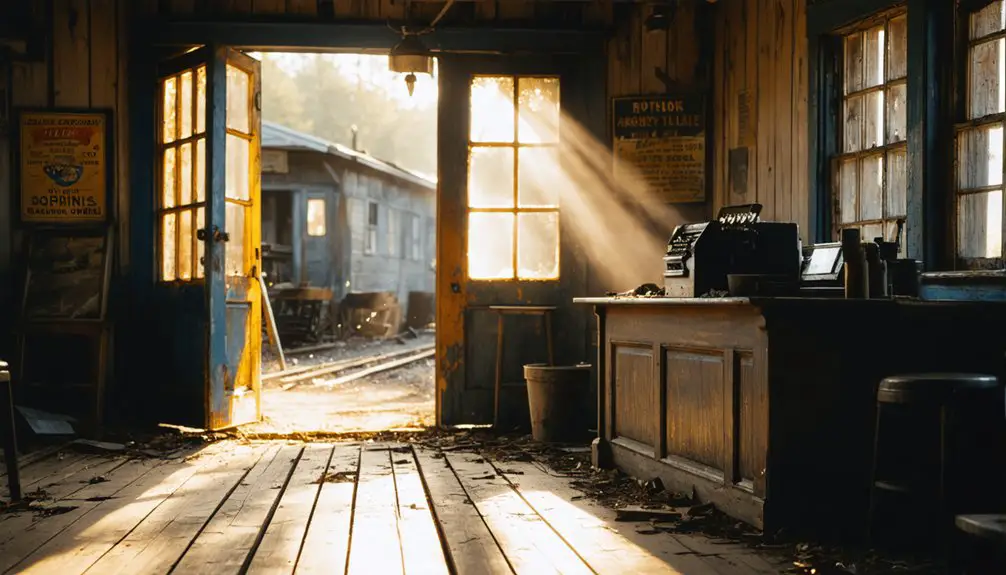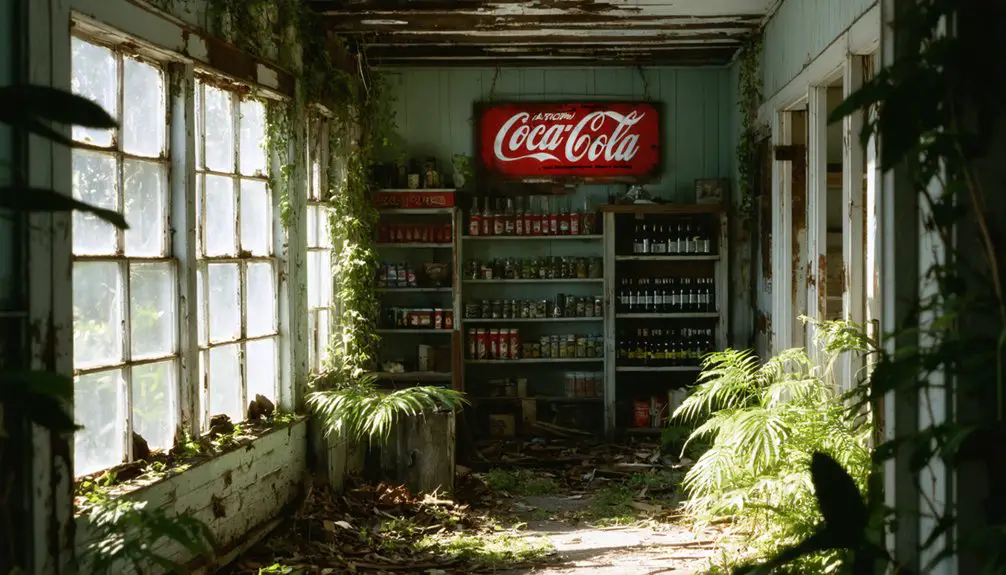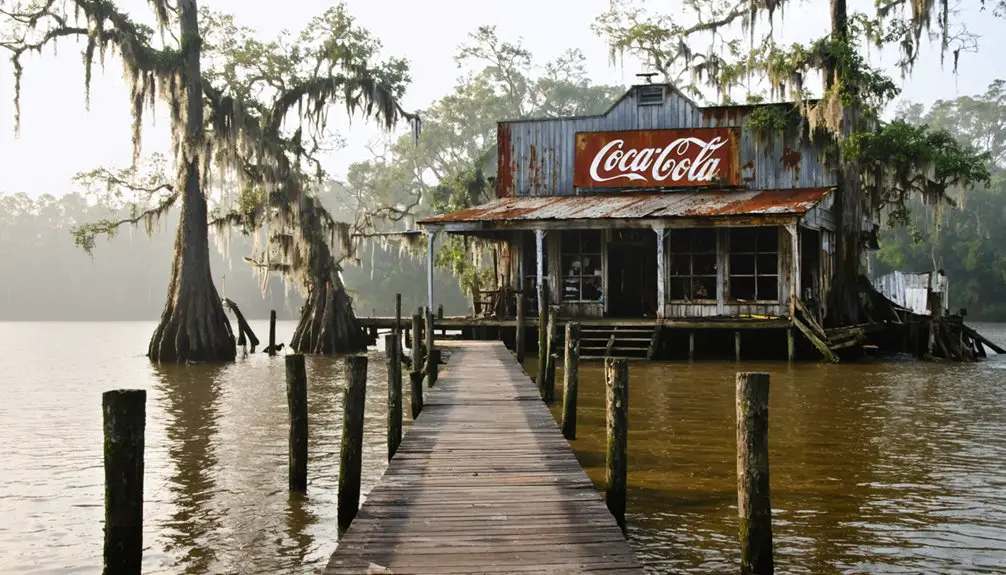You’ll find Locosee along Florida’s eastern corridor, where it flourished as a railroad and turpentine production hub in the early 1900s. The town grew around the Florida East Coast Railway, with workers extracting pine sap using the Herty Cup system while enduring harsh conditions and debt peonage. After the railroad’s discontinuation, this once-bustling community declined into abandonment. Today’s remnants tell a complex story of economic boom, social struggles, and ultimate decline.
Key Takeaways
- Locosee emerged as a settlement in early 1900s Florida, driven by the Florida East Coast Railway’s development along the eastern corridor.
- The town’s economy centered on turpentine production from pine forests, employing workers under harsh conditions using the Herty Cup system.
- Railroad infrastructure served as the community hub, facilitating goods transport and social gatherings around the station and general store.
- Workers faced severe housing shortages and difficult living conditions, with multiple people sharing beds in shifts amid frontier-like circumstances.
- The town’s decline began with railroad service discontinuation, and its remote location combined with dependence on turpentine led to abandonment.
Origins of a Black Bear Town
Before Florida’s rapid development in the early 1900s, the small settlement of Locosee emerged in an area densely populated by Florida black bears (Ursus americanus floridanus).
You’d have found these native bears thriving throughout the region’s diverse ecosystems of swamps, flatwoods, and forests, where they’d established themselves as a keystone species.
As the timber industry expanded and logging operations intensified across northwest Florida, both Locosee and the bears faced mounting conservation challenges.
The bears’ population plummeted from thousands to just a few hundred by the 1970s, primarily due to habitat destruction and overhunting.
The transformation of these ancestral bear lands marked a critical turning point, highlighting the complex relationship between human development and wildlife preservation in Florida’s evolving landscape. Today’s Florida black bears are highly adaptable, living in diverse habitats from sand-pine scrub to tropical hammocks.
Through dedicated conservation efforts, the Florida black bear population has made a remarkable recovery, now reaching over 4,000 bears statewide.
Life Along the Florida East Coast Railroad
The Florida East Coast Railway reshaped the state’s eastern corridor after its 1895 formation, turning isolated settlements into bustling communities. You’d have witnessed the railroad’s influence transforming sleepy coastal towns into vibrant economic hubs, as trains carried citrus, sponges, and turtle meat to northern markets.
The railway’s presence sparked rapid development – wherever stations appeared, you’d soon find newspapers, power plants, and water systems following suit. The Florida Legislature helped spur this growth in 1889 when they set aside 10 million acres for entrepreneurs building new rail lines. The railroad’s founder Henry Flagler established luxury hotels like the Royal Poinciana to attract wealthy tourists.
Life along the tracks wasn’t easy for everyone, though. Immigrant laborers faced harsh, often exploitative conditions during construction, particularly on the ambitious Key West extension.
Still, the railroad’s economic transformation of Florida’s east coast was undeniable, creating new opportunities for trade, tourism, and settlement that would forever change the region’s character.
The Turpentine Trade Era
You’ll find that Locosee’s turpentine operations followed standard naval store production methods of the early 1900s, using Herty Cup systems to extract pine sap that workers transported to local stills for processing into turpentine and rosin.
The primarily African American workforce endured harsh conditions typical of Florida’s turpentine camps, including payment in company scrip and restrictive company store policies that often led to debt peonage. Workers carved distinctive “cat face” patterns into pine trees to channel the flowing sap. As operations depleted pine forests, the camps gradually moved southward through Florida.
The Florida East Coast Railroad provided essential distribution links for Locosee’s naval stores, enabling efficient transport of 50-gallon barrels to major markets throughout the Southeast.
During Florida’s turpentine trade era, naval store production relied heavily on primitive but effective extraction methods from longleaf pine trees.
You’d find workers using axes to cut deep “boxes” into tree trunks, creating “catface” cuts that collected valuable sap. While effective, this brutal technique often killed trees and depleted entire forests.
Everything changed in 1902 when Dr. Charles Herty introduced his clay cup system. You could now collect resin more efficiently using mounted cups and metal gutters, saving countless trees.
Workers would transfer the collected resin to 50-gallon barrels for processing. Inside wood-fired stills, copper kettles transformed 300 pounds of resin into 75 gallons of turpentine through a distillation process that took just a few hours, using a copper “worm” coil to condense the vapor. The demand for turpentine was so high that it became as essential as modern petroleum in the 19th century. Some workers were paid in company script instead of real wages, trapping them in a cycle of poverty.
Workers and Living Conditions
While resin extraction methods evolved with technological advances, life in turpentine camps remained brutally demanding for workers.
You’d find laborers starting their grueling workdays at 4:30 A.M., continuing until after sunset with just a 30-minute lunch break. Worker exploitation reached extreme levels, especially for convict laborers who produced 30% more output than free workers while receiving no pay.
Living conditions were harsh in these remote camps, where you’d see anything from canvas tents to movable pine-wood structures. The camps were supported by essential workers like cooks and blacksmiths who helped maintain a sense of community. At camps run by companies like Knabb Turpentine, workers were subjected to frequent beatings to maintain control.
Workers faced a system designed to trap them through company scrip and inflated store prices, creating inescapable debt. For convict laborers, primarily African American men, conditions were even worse.
Death rates could reach two dozen annually per camp, with brutal treatment and neglect going largely unchecked by authorities.
Railroad Distribution Network
The Florida East Coast Railway emerged as the backbone of Florida’s turpentine trade, transforming from its humble beginnings as the Jacksonville, St. Augustine and Indian River Railway.
Under Henry Flagler’s leadership after 1895, railroad expansion accelerated dramatically, with tracks extending southward from Daytona Beach to Fort Pierce and West Palm Beach.
You’ll find that this extensive rail network revolutionized freight transportation for the turpentine industry.
Branch lines connected remote pine forests to main routes, while new facilities in Hialeah and Jacksonville’s Bowden Yard handled bulk shipments efficiently.
By 1926, double tracking between Jacksonville and Miami accommodated increased industrial traffic.
The railroad’s strategic development meant turpentine producers could now ship their products year-round, faster than ever before, directly from forest camps to coastal ports and processing centers.
Daily Life in a Railroad Boomtown

If you’d visited Locosee during its boom years, you’d have witnessed the bustling railroad station where four daily trains transported passengers and freight across 450 miles of track, while turpentine workers labored in the surrounding pine forests collecting resin.
You’d have found workers renting beds in shifts due to severe housing shortages, with up to six men sharing a single bed over 24 hours.
After long workdays, residents gathered at the town’s numerous saloons and entertainment venues, where railroad workers, merchants, and opportunists mingled in the frontier atmosphere.
Railroad Station Activities
Life at Locosee’s railroad station pulsed with daily rhythms of arrivals and departures, creating a vibrant hub of community activity during the town’s boom years.
You’d find station amenities like waiting rooms, ticket offices, and telegraph services supporting both travelers and locals who gathered to exchange news and greet visitors.
The station’s freight operations kept Locosee’s economic lifeline flowing, as workers loaded turpentine barrels, timber, and agricultural goods for transport to larger markets.
You could watch porters and laborers hustling to load cargo while station agents managed schedules and documentation.
Station workers coordinated the complex dance of incoming supplies and outgoing products, while maintenance crews kept the tracks and equipment running smoothly.
This essential transportation link drove the town’s growth until rail service declined in the 1940s.
Working the Turpentine Fields
Beyond the bustling railroad station lay Locosee’s economic engine – the vast turpentine fields where workers spent grueling days extracting valuable pine sap.
You’d find laborers carving distinctive “cat face” notches into longleaf pines using axes and adzes, a practice that dominated turpentine harvesting. The work was brutally demanding – cutting daily grooves to maintain sap flow while managing Herty cups and metal gutters that caught the precious resin.
After collection, you’d see the sap being distilled in copper stills, where every 50 gallons yielded about 10 gallons of turpentine through a water-cooled copper “worm.”
Labor challenges were severe. Workers lived in isolated camp housing, trapped by company scrip payments and forced to shop at camp stores.
The harsh conditions, long hours, and exposure to toxic fumes made turpentine work one of Florida’s most punishing industries.
Community Social Gatherings
Where would you find most Locosee residents after a long day’s work? You’d likely spot them gathering near the railroad station, the town’s bustling social hub, or at the general store exchanging news about recent train deliveries.
These weren’t just casual meetups – they formed the backbone of community traditions in this town of 370 people.
You’d witness social cohesion in action through various gatherings: impromptu dances in the evening, communal meals among turpentine workers, or weekend church services that brought families together.
The railroad’s rhythm dictated much of the social calendar, from the arrival of traveling entertainers to the distribution of newspapers and mail.
Whether at the town hall for celebrations or on shaded porches for storytelling, you’d find a tight-knit community making the most of their frontier life.
The Path to Abandonment

Although Lokosee once thrived as a bustling railroad stop with 370 residents, its path to abandonment began when Henry Flagler’s Florida East Coast Railroad discontinued service to the area.
Without transportation infrastructure, the town’s economic resilience crumbled quickly. You’ll find that Lokosee’s dependence on turpentine production proved fatal – the single-industry economy couldn’t survive without rail connections to larger markets.
The remote location off U.S. Highway 441 offered few alternatives for development. As residents lost their livelihoods, they departed swiftly, leaving behind deteriorating buildings and empty streets.
Modern Remnants at Lokosee Ranch
The old railroad substation stands as the most prominent remnant of Lokosee’s once-bustling past, now secured behind the fencing of private Lokosee Ranch property.
You’ll find the site nestled off U.S. Route 441 between Kenansville and Yeehaw Junction, though you can’t explore it freely due to strict access limitations. “No Trespassing” signs ward off curious visitors, while natural vegetation steadily reclaims the abandoned town’s footprint.
Beyond the substation, other unidentified structures might still exist, but they’re largely hidden by overgrowth.
The lack of formal remnant preservation efforts means these historical structures remain frozen in time, protected only by their isolation and private ownership.
The site’s restricted status has inadvertently preserved what’s left of this former turpentine boomtown‘s physical heritage.
Frequently Asked Questions
Were There Any Documented Conflicts Between Settlers and Seminole Indians in Lokosee?
You’ll find documented settler tensions at Lokosee during the 1838 Loxahatchee River battles, where fierce Seminole resistance led to major clashes with Lt. Powell’s forces and later Gen. Jesup’s troops.
What Natural Disasters or Severe Weather Events Impacted the Town?
Like a blank canvas waiting to be painted, you’ll find no documented evidence of hurricane damage, flooding impacts, or other major natural disasters that directly affected Lokosee during its inhabited years.
Did Any Notable Crimes or Lawlessness Occur During Lokosee’s Peak Years?
You won’t find documented crime statistics or law enforcement records showing notable lawlessness in Lokosee’s peak years. The small population of 370 residents likely maintained order within their close-knit community.
What Happened to the Original Buildings and Homes After Abandonment?
With less than 5% of original structures surviving today, you’ll find most abandoned structures deteriorated naturally or were dismantled after the railroad’s closure. The substation remains one of few buildings escaping historical preservation challenges.
Were There Any Schools or Churches Established During the Town’s Existence?
You won’t find conclusive evidence of formal schools or churches in Lokosee’s records. Education opportunities and religious gatherings likely occurred in nearby established towns or through informal community meetings.
References
- https://www.ghosttowns.com/states/fl/lokosee.html
- https://patchproflorida.com/blog/the-fascinating-history-of-floridas-ghost-towns/
- https://www.tiktok.com/@socialshepherdadventures/video/7342301852702100778
- https://www.pinterest.com/pin/lokosee-ghost-town–270356783855715101/
- https://www.youtube.com/watch?v=VQSe3zQ-g4s
- https://en.wikipedia.org/wiki/Florida_black_bear
- https://gardenandgun.com/articles/whats-behind-all-the-bear-sightings-in-florida/
- https://www.youtube.com/watch?v=iU_RJI4by44
- https://myfwc.com/hunting/bear/
- https://floridawildlifefederation.org/florida-black-bear/



